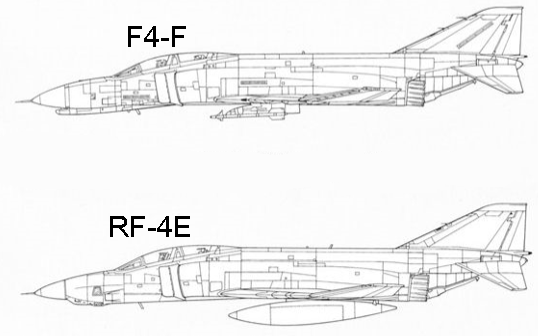The F-4 Phantom
The Era of the McDonnell Douglas F-4 Phantom in the Luftwaffe (German Air Force)
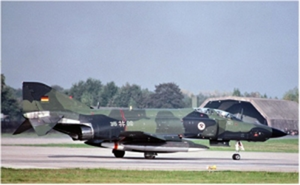
In line with the cautious de-escalation policy introduced in the 1960s and the gradual increase in strength of conventional forces, NATO abandoned the strategy of „Massive Retaliation“ and adopted the concept of „Flexible Response“. As a consequence, this resulted in the requirement to increase the conventional capabilities of the German Air Force.
In order to do so, a decision was reached to replace the F-104 G “Starfighter” in the reconnaissance and air superiority roles and to supplement the Fiat G-91 and the F-104 G in the close air support and ground attack roles with the RF-4E and F-4 F versions of the more capable Phantom II.
Initially developed as a carrier-based air superiority fighter for the US-Navy, the XF4H-1 “Phantom II” took to the air for the first time in May 1958.
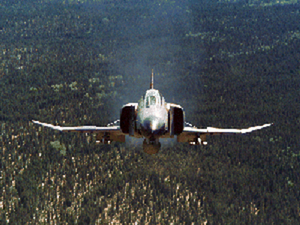
As a proof of her extraordinary performance, the F-4H in 1961/62 surpassed all climb- and speed records, which were previously for the most part held by the F-104. For example, an altitude of 9000 m was reached within 61 seconds after break release, and a record speed of 2.585 km/h was achieved.
Evaluation flights ordered by the Pentagon against the Air Force fighters F-104, F-105 and F-106 proved the Phantom´s superiority and resulted in procurement of the Phantom II for the US Air Force as well. Soon, the F-4 became the mainstay of the Air Force fighter fleet.
For three decades from the mid-60s to the mid-90s the “Phantom” asserted herself as one the most successful fighter aircraft in Air Force history. During the Vietnam War she was the mainstay of the US Air Force and proofed herself in the air-to-air, air-to-ground as well as reconnaissance roles. Even after newer types gradually took over her roles and missions, she was still active during Desert Storm (as F-4G Wild Weasels) and the ensuing No-Fly Zone enforcement over Iraq.
By the time the production line closed in 1981, all in all 5.195 “Phantom II” for 12 nations were produced.
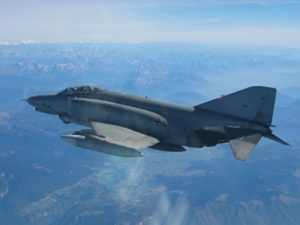
Between 1971 and 1976 the German Air Force procured 263 „Phantom II“; of those 88 were RF-4 E and 175 F-4 F versions, which together equipped 6 Fighter-, Fighter Bomber- and Reconnaissance Wings. For a considerable time, these wings formed the German Armed Forces´s backbone for airborne reconnaissance, conventional ground attack and airborne air defense.
As a consequence of this major conversion the training requirements for the aircrews were defined and it was concluded that training should be conducted in the United States.
The mission to convert the German aircrews was given to the 20th Tactical Fighter Training Squadron „Silver Lobos“ of the 35th Tactical Fighter Wing in George AFB, California. From 1971 to 1976 altogether 240 recce-, fighter- and fighter-bomber-pilots were converted to the “Phantom” from their previous weapon systems, and 24 instructors were trained.
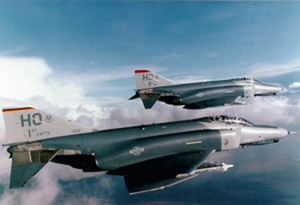
In order to ensure the follow-on regeneration of German F-4F “Phantom” aircrews, the 3. German Air Force Training Squadron USA was activated on 1 April, 1976 in George AFB and renamed into 1. German Air Force Training Squadron USA on 1 October, 1984.
From 1970 on the German aircrews of the reconnaissance version RF-4 E were already trained at the 363rd Tactical Reconnaissance Wing (TRW) of the US. Air Force in Shaw AFB, South Carolina (until 1972 only instructors). From 1982 until 1991 this task fell to the 67th TRW in Bergstrom AFB, Texas. After that, for a short time the remaining German RF-4 E students were trained together with the F-4 F aircrews in George AFB, until the German Air Force ceased operating their RF-4 E´s in 1993.
Following the US government decision to close George AFB, the 1. German Air Force Training Squadron USA was relocated to Holloman AFB, New Mexico, on 2 June, 1992. The training here ended on 20 December, 2004, thus terminating a very successful episode of American as well as German aviation history.
The Team
With the „Phantom II“ the German Air Force for the first time introduced a combat aircraft which required a crew of two. Although 2-seater versions of the predecessors existed, these were very few in number and they were used exclusively for training purposes.
In the „Phantom“ on the other hand pilot and weapons system officer (WSO) formed a team. They shared the cockpit tasks. The pilot had the overall responsibility for the mission, he steered and controlled the aircraft. The WSO operated the avionics for navigation and weapons employment, he supported the pilot with electronic warfare, during air combat operations and with normal and emergency procedures.
Only when the team Pilot-WSO functioned perfectly was the aircraft optimally capable as a weapons system.
The RF-4 E’s reconnaissance mission was taken over in 1994 by the Tornado, a two-seater like the Phantom. Starting in 2004 the remaining F-4 F Phantoms were replaced with the Eurofighter “Typhoon”, a single-seat fighter aircraft. The last Phantom left the German Air Force on 13 June 2013. Thus, after more than 40 years, the era of the “Phantom” in the Luftwaffe reached its end.
German original:
K. Hammann, March 2018
Translated:
Jürgen Erbeck, April 2018
Airbases in Germany
| Airbase Bremgarten | Reconnaissance Wing 51 "Immelmann" | RF-4E Phantom II | from January 20th 1971 | until March 1993 |
| Airbase Leck | Reconnaissance Wing 52 | RF-4E Phantom II | from September 1971 | until December 1993 |
| Airbase Wittmundhafen | Fighter Wing 71 "Richthofen" | F-4F Phantom II | from August 1973 | until June 29th 2013 |
| Airbase Neuburg | Fighter Wing 74 "Mölders" | F-4F Phantom II | from September 1974 | until June 2008 |
| Airbase Hopsten | Fighter Bomber Wing 36 / Jagdgeschwader 72 "Westfalen" | F-4F Phantom II | from February 1975 | until December 2005 |
| Airbase Pferdsfeld | Fighter Bomber Wing 35 | F-4F Phantom II | from April 1975 | until July 1997 |
| Airbase Laage | Fighter Wing 73 "Steinhoff" | F-4F Phantom II | from July 1997 | until April 2002 |
| Airbase Manching | Flight Test Center 61 | RF-4E/F-4F Phantom II | from 1974 | until July 30th 2013 |
Technical Data
| Manufacturer: | McDonnell Douglas | Weapons F-4F: | M61A1 Vulcan internal 6x 20 mm Gatling Gun, 640 Rounds available, at a firing rate of 6.000 Shots/Minute or 100 per Second. |
| Engine: | 2 x General Electric J79-GE-17A | up to 4 AIM-9L short range air-to-air missiles (infrared)), | |
| Performance / Thrust/: | 2 x 52,5 kN (79,24 kN – or 17.900 lbs - with Afterburner) | and up to 4 AIM-120 AMRAAM medium range air-to-air missiles (radar). | |
| Length: | 19,20 m | For her Air to Ground Mission additionally various retarted and slick general purpose bombs, the cluster bomb BL 755 and the TV-guided Maverick missile. | |
| Height: | 5,02 m | Sensors and Bombs RF-4E: | Vertical or forward looking camera, left and right oblique cameras, panoramic camera, medium and high altitude cameras, Infrared Sensor AN/AAD 5 and Side Looking Airborne Radar (SLAR) AN/APD 4. After 1980 the German RF-4E could also carry up to 2.270 kg of external bombs |
| Wing span: | 11,70 m | External Tanks: | Additionally, both versions could carry one centerline and/or two pylon external fuel tanks. |
| Empty Weight: | 13.800 kg | Crew: | 2 (Pilot / Weapon System Officer) |
| Max. Takeoff Weight: | 28.000 kg | First Flight: | 27 May 1958 |
| Max. Speed: | 1.300 km/h Low Altitude / Mach2.2 in 40 000’ | ||
| Cruise Speed: | .87 Mach or 950 km/h | ||
| Max. Altitude: | 55.000‘ | ||
| Operational Range: | 1.150 km | ||
| Transfer Range | 3.180 km |


